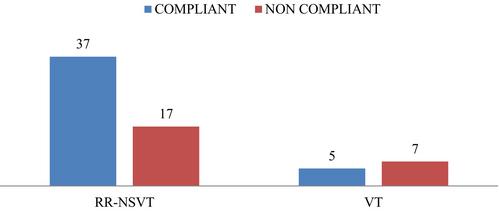Incidence of Rapid Rate Non-Sustained and Sustained Ventricular Tachycardia in Implantable Cardioverter-Defibrillator Recipients and Its Correlation With Heart Failure Guideline-Directed Medical Therapy Compliance
Abstract
Background
Ventricular arrhythmias are prevalent among heart failure with reduced ejection fraction (HFrEF) patients. Rapid rate non-sustained ventricular tachycardia (RR-NSVT) and sustained ventricular tachycardia (VT) can be detected on implantable cardioverter-defibrillator (ICD) interrogation due to discrimination algorithms that differentiate supra-ventricular from ventricular tachycardia. This study aims to assess the incidence of RR-NSVT and sustained VT on ICD interrogation and their correlation with HFrEF guideline-directed medical therapy (GDMT) compliance.
Methods
DesignCross-sectional, analytical study. SettingHeart rhythm device clinic, Electrophysiology department, National Institute of Cardiovascular Diseases (NICVD), Karachi, Pakistan. ParticipantsPatients implanted with dual chamber ICD or cardiac resynchronization therapy defibrillator (CRT-D), aged 18 years or above with HFrEF. Outcome MeasureCovariates included demographics, comorbidities, medications, GDMT compliance, and cardiac rhythm device parameters. Incidence of RR-NSVT, sustained VT, and their correlation with HFrEF GDMT compliance was assessed using multivariate logistic regression.
Results
Study evaluated 139 patients. Men 77.7%. The mean age was 56.4 ± 13.9 years. The mean LV ejection fraction was 26.4% ± 5.5%. 109 (78.4%) were GDMT compliant (94.3% on beta-blockers, 93.5% on renin-angiotensin inhibitors, 71.9% on aldosterone antagonists, and 15.8% on SGLT-2 inhibitors). RR-NSVT episodes were observed in 54 (38.8%) patients, out of whom 37 had RR-NSVT despite GDMT compliance, although this correlation was not statistically significant. Twelve (8.6%) patients had sustained VT, which was significantly less common with GDMT compliance.
Conclusion
More than one-third of participants had RR-NSVT episodes despite HFrEF GDMT compliance. These patients also had associated sustained VT episodes, the occurrence of which was significantly less with GDMT compliance.


 求助内容:
求助内容: 应助结果提醒方式:
应助结果提醒方式:


